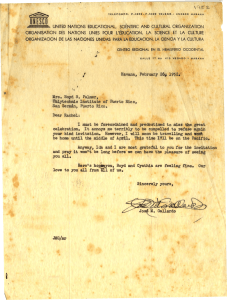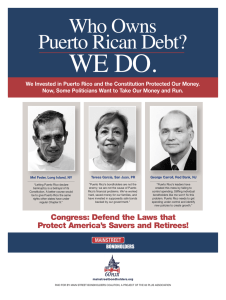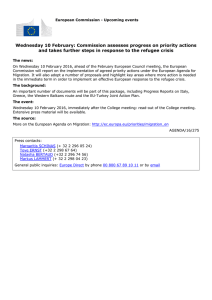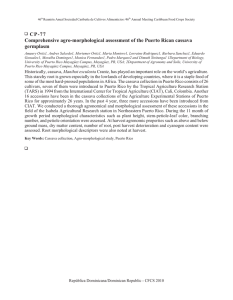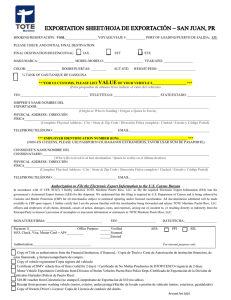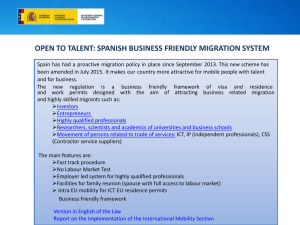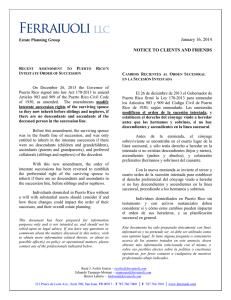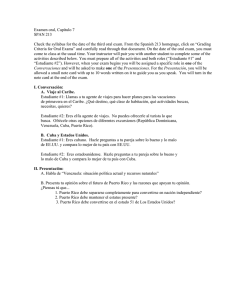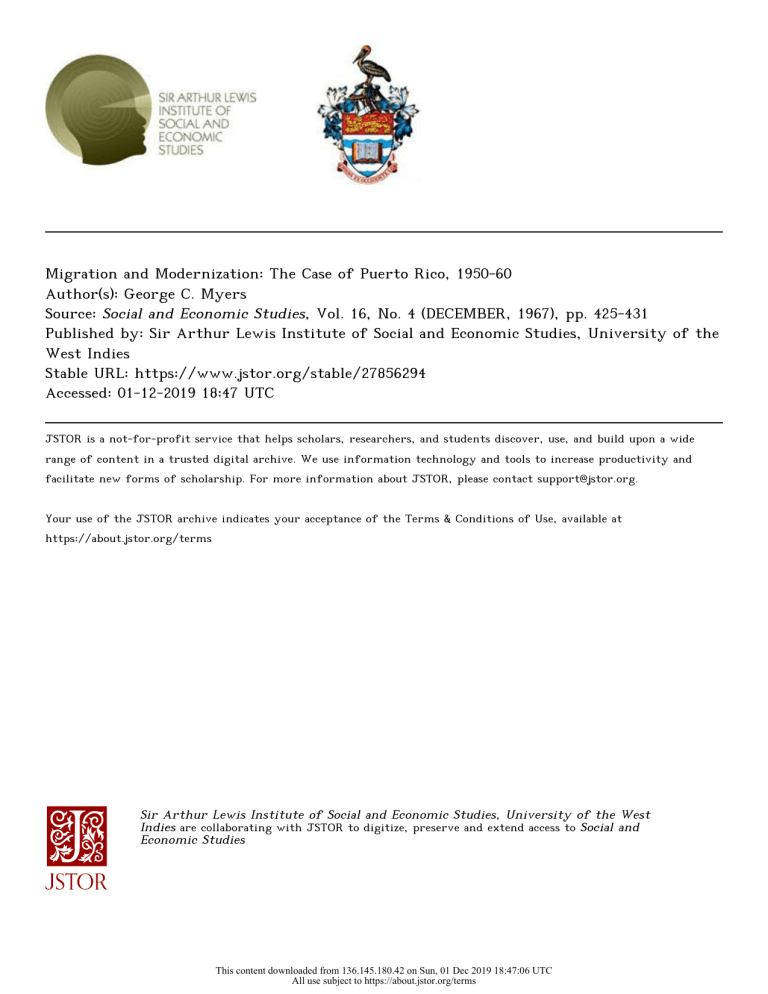
Migration and Modernization: The Case of Puerto Rico, 1950-60 Author(s): George C. Myers Source: Social and Economic Studies, Vol. 16, No. 4 (DECEMBER, 1967), pp. 425-431 Published by: Sir Arthur Lewis Institute of Social and Economic Studies, University of the West Indies Stable URL: https://www.jstor.org/stable/27856294 Accessed: 01-12-2019 18:47 UTC JSTOR is a not-for-profit service that helps scholars, researchers, and students discover, use, and build upon a wide range of content in a trusted digital archive. We use information technology and tools to increase productivity and facilitate new forms of scholarship. For more information about JSTOR, please contact [email protected]. Your use of the JSTOR archive indicates your acceptance of the Terms & Conditions of Use, available at https://about.jstor.org/terms Sir Arthur Lewis Institute of Social and Economic Studies, University of the West Indies are collaborating with JSTOR to digitize, preserve and extend access to Social and Economic Studies This content downloaded from 136.145.180.42 on Sun, 01 Dec 2019 18:47:06 UTC All use subject to https://about.jstor.org/terms Migration and Modernization: The Case of Puerto Rico, 1950-60 By George C. Myers The role of migration in the process of modernization and regional devel opment is confounded in the case of Puerto Rico by the fact that both ex tensive internal and international migration occurred in the post-World War II era. In this respect, the case shares similar features with many Western European countries during their heavy period of emigration.1 How ever, in several important respects the experiences differ: (1) Puerto Rico holds commonwealth status within the United States and Puerto Ricans, as citizens, can travel freely between island and mainland; (2) the period of very widespread movement, 1947-1960, lasted less than 15 years and has apparently now run its course.2 Most scholars agree that the migration from Puerto Rico to the mainland of the United States was motivated by the quest for economic opportunities, not by a desire for a new way of life.3 For many this meant only a temporary stay in the United States; a conclusion sup ported by the substantial reverse migration even during years of the heaviest out flow, and more recently the large return migration to Puerto Rico.4 This is further facilitated by the inexpensive and rapid air transportation between the two places. Therefore, it may be more reasonable to discuss all forms of Puerto Rican migration as essentially "internal migration,'' treating external migration as one feature of the general process. This report examines sev eral forms of net migration for the 76 municipios of Puerto Rico between 1950 and 1960. IB. Thomas, "Long Swings in Internal Migration and Capital Formation," Bulletin of Inter national Statistical Institute, XL, 1963, pp. 398-412, and D. S. Thomas, Social and Economic Aspects of Swedish Population Movements, 1750-1933, Macmillan Co., New York, ?941. 2According to published estimates on departures and arrivals in Puerto Rico, the net ex ternal out-migration declined in 1959 and 1960, and actually recorded a net in-migration in 1961, 1963 and 1965. See: Puerto Rico Planning Board, Statistical Yearbook, Puerto Rico, Volumes 1-11. 3J. L. Vazquez Calzada, La Emigracion Puertorriquena, Solucion O Problema? Seccion de Biostadisticas Escuela de Medicina, San Juan, Puerto Rico, August, 1963. The high correlation between economic conditions in the United States and Puerto Rican emigration has been clearly established in several investigations. 4 There were 34,040 Puerto Rican natives enumerated in the 1960 census who reported they resided in the United States in 1955. For an expanded discussion of this issue, see: J. Hernandez Alvarez, Return Migration in Puerto Rico, Institute of International Studies, Uni versity of California, Berkeley, 1967. It also should be noted that a total of 55,648 persons residing in Puerto Rico in 1960 were abroad in the United States in 1955. 425 This content downloaded from 136.145.180.42 on Sun, 01 Dec 2019 18:47:06 UTC All use subject to https://about.jstor.org/terms 426 SOCIAL AND ECONOMIC STUDIES Modernization in Puerto Rico, 1950-1960 Puerto Rico in the decade between 1950 and I960 underwent a massive development that touched upon all aspects of society. In the fields of edu cation, public health, transportatiqn development and power sources, un precedented progress was made. While the foundation for these advances was laid in the previous decade through such programmes as Operation Bootstrap, the results largely occurred in the 1950-60 period. In 1956 in come from manufacturing exceeded that from agriculture, marking what many consider the critical point in the development of a modern society. The transition also can be examined in demographic terms as well. The rapid increase in population that characterized Puerto Rico in prior periods was definitely curtailed in the most recent intercens?l period, 1950 to 1960. From a percentage increase of 18.3 per cent between 1940 and 1950, the population increased by only 6,3 per cent during the ten-year period 1950 to 1960. While some of this decline can be attributed to re ductions in fertility levels, the major factor was out-migration from Puerto Rico. In fact, without these migration losses Puerto Rico's population would have increased by 27.5 per cent in the ten-year period, and this figure excludes births that would have occurred to persons if they had not moved, but remained in Puerto Rico. While; the aggregate figures for Puerto Rico describe the general sit uation, it is also necessary to examine the complex redistribution of popu lation within Puerto Rico itself. Only five municipios put of 77 declined in population between 1940 and 1950, while over half recorded population losses during the 1950-1960 period. These losses reflect the important role that urbanization and migration play in the process of population redistri bution. In subsequent sections we will examine how these factors were in strumental in producing variation in population growth. What type of areas grew the most and which showed the least growth? And what factors were responsible for municipio change in population? The transition from an agricultural society to an industrialized modern society has generally been accompanied by rapid urbanization of the popu lation. In Puerto Rico this has certainly been true, although some confound ing issues are introduced. Since rates of natural increase are usually highfer in rural areas than in urban areas, the growth of urban places depends on substantial net in-migration. For Puerto Rico the percentage of population residing in urban places (places with more than 2,500 population)5 increased from 14.6 per cent in 1899 to 40.5 per cent in 1950. However, the urban percentage did not increase , at all between 1950 and 1960 and remained 40.5. In 1960 a new definition of urban population was introduced that includes persons residing in urbanized areas around the larger cities as well as per 5The previous definition of urban population used in 1950 d?es n?t include the urbanized areas of Mayaguez, Ponce, and San Juan, but only their municipal boundaries. This content downloaded from 136.145.180.42 on Sun, 01 Dec 2019 18:47:06 UTC All use subject to https://about.jstor.org/terms MIGRATION AND MODERNIZATION: PUERTO RICO 427 sons Hying in places of over 2,500 population. Using this current definition, urban population increased 16.1 per cent in the past intercensal period, and constituted 44.2 per cent of the total population, while the population in rural areas declined slightly (.4 per cent). This arises largely from the fact that urbanized areas are included in this figure; when they are excluded, the urban population increase was only 6.2 per cent between 1950 and 1960. A more detailed examination of rural and urban growth by size of place is provided by Table 1. TABLE 1. Percentage Change Between 1950 and 1960 in Rural and Urban Places According to Size in 1960 (Previous urban definition) Type of Place Urban Places of Places of Places of Places of Places of Places of Rural Percentage Change 100,000 or more 50,000 - 100,000 25,000 - 50,000 10,000 - 25,000 5,000 - 10,000 2,500 - 5,000 Places of 1,000 - 2,500 Places under 1,000 Other rural territory Standard Metropolitan Statistical Areas Mayaguez Ponce San Juan 6.2% 53.0 -68.3 (16.1% Current urban definition) - 1.0 -31.3 -9.3 14.5 6.3 - 6.2 53.2 6.7 -.4) (?4) - 4.0 14.8 26.4 Source: U.S. Bureau of the Census, United States Census of Population: I960, Number habitants', Puerto Rico, 'inal Report PC(1)-53A, Table 3, p. 10. The urban growth is concentrated primarily in the largest and sm urban places,, those over 100,000, and below 5,000 population as sh Table I. The cities with the heaviest losses are found in the 50,000 to population interval in 1960, while cities over 100,000 show the largest gr Much of this growth is in the Ponce and San Juan Standard Metrop Statistical Areas. On the other hand, Mayaguez, a Standard Metrop Statistical Area of 83,850 persons in 1960, lost population during the censal period. The rural areas had a similar rate of intercensal growt pared with the urban areas, using the previous census definition of u but a slight loss using the current definition. Small rural towns over lost population, while the very few places under 1,000 show a gain more populated rural territory registered a gain of 6.7 per cent dur decade. From these data, it is clear that the trend toward urbaniza Puerto Rico was attenuated between 1950 and I960. Growth was pri concentrated in the largest cities, while the intermediate-sized citi population. The rural areas did not evince rapid growth, either, gai about the same rate as the urban areas. The population changes are examined by rural arid urban areas wi municipios in Table 2. The overall impression is that a high deg variation in municipio population change was evident for the perio This content downloaded from 136.145.180.42 on Sun, 01 Dec 2019 18:47:06 UTC All use subject to https://about.jstor.org/terms 428 SOCIAL AND ECONOMIC STUDIES TABLE 2. Distribution of Municipios by Change in Population Between 1950 and 1960 and Change in Rural and Urban Per Cent of Total Municipio Population 1950-60. (No change shown where less than . 1 per cent. ) 1950-60 Change in Rural and Urban Percentage of Total Municipio Population Gain Loss No change Total Urban gain ? rural gain 10 .... 10 Urban gain ? rural loss 3 8 11 Urban loss ? rural gain 12 7 1 20 Urban loss ? rural loss . . 7 . . 7 No urban change ? rural gain 1 . . . . 1 No urban change ? rural loss 1 1 No 1950 urbana ~- rural gain 6 . . 6 No 1950 urbana - rural loss 3 16 .. 19 No 1950 rural ? urban gain 1 . . 1 Total 36 39 a Impossible 1 to 76 compute Source: U.S. Bureau of habitants, Puerto Rico example, only thr lation and rural l twenty that had u appears that the than lation. urban change Internal and External Migration According to the theoretical position taken in this paper one of the fea tures of the modernization process is a complex redistribution of population; attributable for the most part to migration. Thus, we expect the level of migration to increase with economic development. In the case of Puerto Rico, the decade of 1950-60 was marked by extensive movement of the popula tion. However, the movement was of two types ? internal migration within the island and external migration from Puerto Rico, mainly to the United States. Therefore, it is necessary to examine both of these factors in some detail, to determine how they are related, and to investigate the complex in terplay of these two forms of migration in the redistribution of population. One of the serious problems in such research is that data on external migra tion are seldom available for small areas; nor are they comparable to exist ing data on internal migration.6 In this report an effort is made to estimate the extent of these two forms of migration for Puerto Rico during the past decade by specifically examining net migration patterns for total and in ternal migration. On the national level, net migration losses largely nullified the gain from natural increase; thereby acting as a safety valve for the otherwise imminent population upsurge. We can also infer that external net out-migration was largely responsible for the slow-down in urbanization. The large cities were 6The major exception is the study of Sweden by D. S. Thomas, op. cit., where these data could be obtained. This content downloaded from 136.145.180.42 on Sun, 01 Dec 2019 18:47:06 UTC All use subject to https://about.jstor.org/terms MIGRATION AND MODERNIZATION: PUERTO RICO 429 clearing houses for the thousands who left Puerto Rico for the United States. In turn migrants came from less populous urban places and rural areas into the cities. Although the rural areas typically have higher natural increase than urban areas, many lost population in the period 1950-60. While it is not possible, given the existing data, to determine in detail the relative ex ternal migration losses for rural and urban areas, it is suggested that external migration drew heavily from rural as well as urban areas. In the former case, this undoubtedly posed the double attraction for rural inhabitants of going to the United States directly or going to a city in Puerto Rico. Once located in a city, the possibility of leaving the island might be yet further enhanced. Information on Puerto Rican internal migration can most readily be obtained from the census item relating present residence to that five years earlier, which is available for both 1940 and 1960. In addition, special census tabulations were made on lesidence in 1955 by present place of residence for those living within Puerto Rico. Thus, it is possible to establish both in and out- internal migration for each municipio and to derive the internal net migration rates used in this paper. The proportion of population 5 years of age and over that reported a move during the five-year period increased only slightly from 6.8 per cent to 8.3 per cent of the population between the two periods. Yet during the latter period a much larger amount of external migration occurred. One can conclude that Puerto Ricans have become much more mobile over this period; a conclusion no doubt related in part to the general economic conditions prevailing during the respective periods as well as the emergent nature of the society. In order to gain some notion of the extent of external migration for in dividual municipios between 1950 and 1960, estimates of total net migra tion were obtained by use of the life table forward survival method. Sur vival rates based on 1954-56 Life Tables for Puerto Rico were applied to the 1950 populations of municipios. Although survival values from the mid dle of the period were utilized, it should be noted that substantial improve ments in life expectancy were made over this ten-year period. These im provements probably occurred early in the decade, so that the average mortality experience thereby underestimates the survival values, and con sequently understates the net migration. In addition a graduation procedure by which the five-year age groups were graduated using the formula of "small extent" was used to reduce distortion in net migration estimates. The value shown in Table 3 of net external migration derived by the life table survival method is the uncompensated portion of total net migration TABLE 3. External Net Migration Estimates, 1950-1960. Life table survival estimate 420,925 Vital statistics residual estimate 468,746 Net passenger travel estimate 443,357 Source: U.S. Bureau of the Census, United States Census of Population: 1950 and United States Census of Population: I960. Puerto Rico Planning Board, Statistical Yearbook, 1950 to I960. This content downloaded from 136.145.180.42 on Sun, 01 Dec 2019 18:47:06 UTC All use subject to https://about.jstor.org/terms 430 SOCIAL AND ECONOMIC STUDIES for the island and should be considered as a rough estimate of the net migra tion for the population 10 years and over in 1960. Although the estimate can be expected to differ from other estimates since it pertains to a selected segment of the population exposed to migration and only represents migrants surviving to the second census date, it seems reasonably comparable to the estimates obtained by other approaches. A comparison of the total net migration rates which cover a ten-year period, and the five-year net internal migration rates yields some pertinent information about variation among different types of municipios in migra tion (see Table 4). These rates are based on the appropriate 1960 popu lations in order to assure some comparability in the rates.7 In the intercensal period only four municipios (Bayamon, Carolina, Guaynabo, and Trujillo Alto) showed total net migration gains. Since these areas are all located con tiguous to San Juan municipio, the gains can largely be attributed to sub urban movement within the metropolitan area. However, municipios con taining the largest cities all show total net migration losses and the overall metropolitan rate is the lowest of the combined rates. In contrast, the rural and smaller urban categories have the highest net out-migration TABLE 4. Rates of Internal Net Migration, 1955-60, and Total Net Migration, 1950-60, per 1,000 Population for Combined Municipios, Puerto Rico (Weighted average rates) Internal Net Total Net Typ? of Areaa Migration Rates (Five-year period) Rural Urban to rural Rural to urban Small urban Migration Rates (Ten-year period) ?28 ?21 -400 -324 ^351 Large urban ?14 ?28 ? 7 -395 Mayaguez Ponce + 12 + 7: -160 Metropolitan San Juanb Total 4-55 + 70 Number of Municipios -308 - 59 -306 19 4 4 7 34 8 1 1 - 5 6 -252 76 a The rural category contains municipios with no urban places (over 2,500 population) in 1950 and 1960. The urban to rural and rural to urban designation describes municipios which lost or gained an urban place between the two census dates. The large urban category contains municipios with over 50 per cent urban population or more than 15,000 urban population exclusive of municipios in metropolitan areas. b The metropolitan area of San Juan determined for this analysis includes Bayamon, Carolina, C Guaynabo, San Juan, and Trujillo Alto municipios. Source: U.S. Bureau of the Census, United States Census of Population: 1950 and United Census of Population: 1960. Also special tabulations of the Puerto Rican Planning Board. The rates of internal net migration are much lower than correspon rates for total net migration,8 and in the case of metropolitan areas are positive. The rural areas and small urban areas show the highest ternal net out-migration, as was true in the case of tot?l net migratio the metropolitan areas, San luan had the highest internal in-mieration ra 7It might be noted that the correlations between rates derived with different base p lations ( average population, etc.) were generally . 99. 8B. Thomas* (op. cit.) also has noted a strong inverse relationship between swings ternal migration and international migration for countries sending migrants abroad, This content downloaded from 136.145.180.42 on Sun, 01 Dec 2019 18:47:06 UTC All use subject to https://about.jstor.org/terms MIGRATION AND MODERNIZATION: PUERTO RICO and naturally the largest numerical in-migration as well. Considering both types of rates, it is clear that there was extensive external net migration from virtually all the municipios and different types of areas in Puerto Rico. If we arbitrarily double the internal net migration rates and take the difference between them and the total net migration rates, it yields an approximation of external net migration.9 The resulting negative rate values are very high. Although the highest external out-migration is appar ently from rural and small urban areas, the external net migration negative rates in the metropolitan areas are also quite large. Numerically, this means a substantial portion of the external out-migration was from municipios that contain the major cities. In short, the net flow of internal migration is from rural municipios and those that contain smaller cities into the metropolitan, areas. Although it is risky to speculate on the specific streams of migration without further information, the results suggest a migration step-flow phenomenon from rural to small cities and finally to metropolitan areas. During this period of heavy external out-migration from the island as a whole, these same areas also experienced substantial external out-migration A correlation of .70 between the two net migration rates indicates some correspondence in the patterns of migration, but leaves 50 per cent of the variance to be explained by other factors. The highlights that emerge from this research can be summarized as fol lows: (1) In the decade 1950-60, Puerto Rico made spectacular progress in social and economic development (2) The increasing.migration of population was of two kinds, internal and external migration with the latter assum ing the greater importance. (3) Among the consequences of this external out-rnigration were the curtailment of substantial population growth for the island as a whole and the attenuation of the trend toward increased urban izatipn of the population. (4) Total net migration losses were experienced by nearly all of the island's municipios, particularly rural municipios and those containing small urban places. The rates of internal net migration were negative forcali types of areas except the metropolitan areas. (5) Puerto Rico appears to have passed from an emigration phase into one in which internal migration, including inter-urban migration, should assume new importance. There also is likely to be accelerated growth of urban population. Further more, the population growth that was controlled in part by external out migration in the 1950-60 decade may be expected to rise unless further re ductions in birth rates are established. ?These approximations should be viewed with extreme caution since they assume similar internal net migration during the first half of the decennial period and they also concern only the migration?survivors. Th? general tendency would be to underestimate the internal net migration. Another approach would, be to derive estimated annual proportions of net movers. For a general discussion of the subject, see H. S. Shryock, Jr., Poptihtion Mobility Within the Uhit?d States, Community and Family Study Center, University of Chicago, Chicago, 1964, pp . 25-26. . This content downloaded from 136.145.180.42 on Sun, 01 Dec 2019 18:47:06 UTC All use subject to https://about.jstor.org/terms 431
